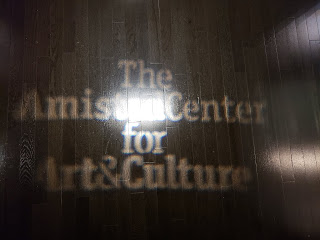My first
trip to the Wadsworth Atheneum Museum of Art left me not only impressed with
the impressive collection of at held within it’s wall, but with its history.
The museum, which first opened its doors in 1844, is the oldest in the country.
The collection includes antiquities for Egypt, Greece, and Rome, modernist paintings,
and European art. The building, itself can considered a piece of art, looks like
a castle.
The first
exhibit I stumbled upon, by total chance, was in the Amistad Room, which housed
an exhibit called Words, Pictures and Music. The exhibit showcased primarily
historical photographs the highlighted the connections between art and social struggles.
Throughout the room were quotes from Langston Hughes, Frederick Douglass, Paul
Lawrence Dunbar, and Gwendolyn Brooks among others.
There was this painting by Elbridge Ayer Burbank of a young black boy smelling a rose entitled American Beauty, 1906. Burbank primarily
painted Native Americans as he was sympathetic to there plight, however his
earliest subject for portraiture were Black children. The title, American
Beauty, one can imagine as being quite controversial at the time.
The next
photograph was by an unknown photographer of depicting the Reverend Benjamin W.
Arnett in his early years. Arnett was a civil rights activist during the 1860s
and would go on to become an elected official for the Ohio General Assembly
where he was instrumental in changing laws that provided equal educational opportunities
for black children. He also became friends with fellow legislator and future
president, William McKinley.
Another rare
photograph showed a young Paul Robeson playing during his football career at
Rutgers University in 1919. The name of the photographer is unknown. Robeson
was multi-faceted as he was a college football All-American, a lawyer, an
actor, an opera singer, and a social activist. The photo shows the early
determination that would come to signify the struggles, and the resolve, that Robeson
would face in the future.
I walked
the museum after leaving the Amistad Room and came upon the Surrealism exhibit called
Surrealism and War in the 1930s and 1940s.
Unfortunately, photography was not allowed on this floor, therefore works by Andre
Breton and others went un-captured.
The below piece
is entitled Apparition of Face and Fruit Dish
on a Beach by Spanish painter Salvador Dali. The painting is true to the Dali’s
style of creating optical illusions with hidden meaning. At the center of this
picture is a bowl in which a face can clearly be seen. This face was a tribute
to his friend, poet Federico Garcia Lorca, who had been murdered by Nationalists
near the start of the Spanish Civil War. Lorca is meant to be the apparition
that the title refers to, and was placed there as a form of protest.
Image
courtesy of Google images
Another Dali
painting, Soft Construction with Boiled Beans, was also present and too alluded to the troubles of the Spanish Civil War. This painting, created six months before the start of the war was prophetic and depicted imagery of two monstrosities that have emerged from one singular creature and are in conflict with each other. This clearly represents Spain and the two sides which will soon come into conflict and inflict much horror upon itself, and thus his beloved homeland.
Image courtesy of Google images
There was
much more Surrealist artist represented, the no photo rule really stymied me.
Among the others who’s works protested the war were Picasso, Blumenfeld,
Breton, Miro, Ernst, and myriad others
What is
the connection between paintings of the Spanish Civil War era and photographs depict
African American history? Artists have often had the tendency to use their art
to speak out against injustices and to inspire outrage at situations. The photographs,
along with the accompanying information cards, celebrates the struggles and triumphs
of African Americans during the late nineteenth century and the early twentieth
century. The paintings of the Surrealists were using their art as a protest
against war. Like renowned photographer Gordon Parks, who considered his camera
to be his weapon, so too do other artist you their respective forms as weapons
against war, bigotry, oppression, and injustice. Few groups have been a keenly aware
of this as were the Surrealists and the Black artists documenting a changing nation.







No comments:
Post a Comment